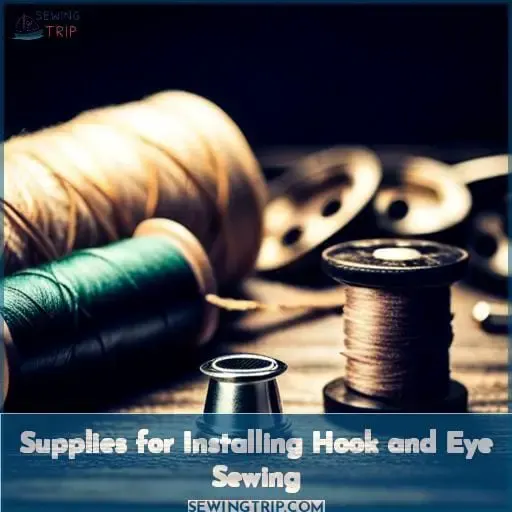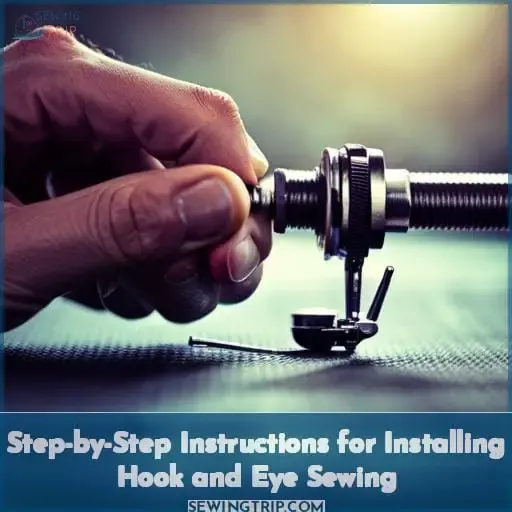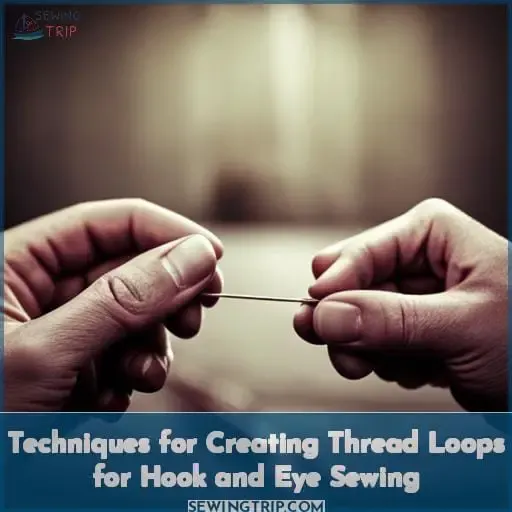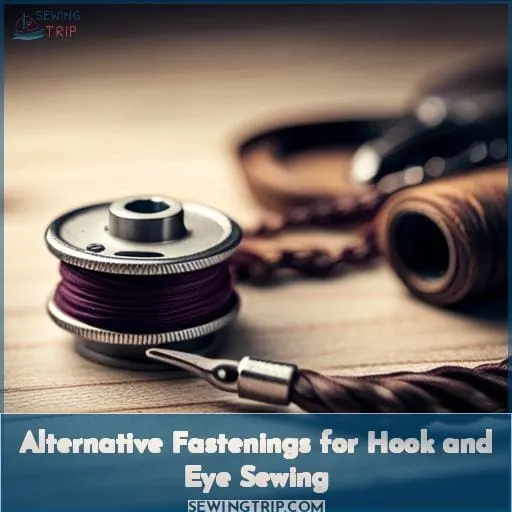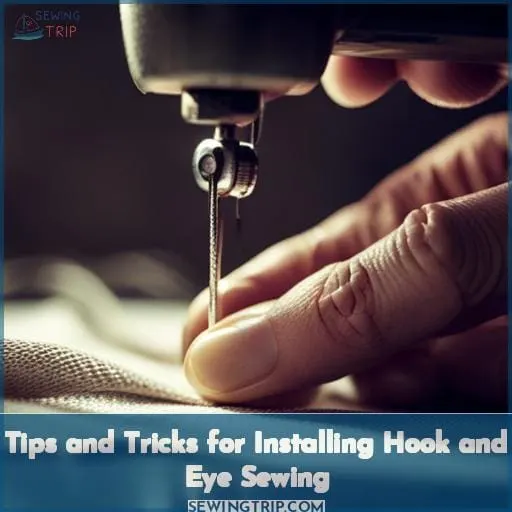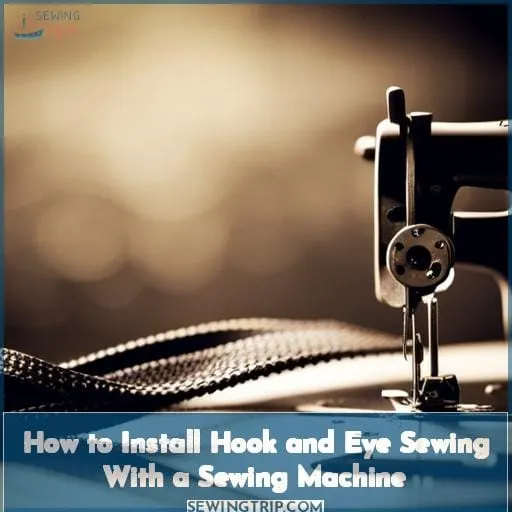This site is supported by our readers. We may earn a commission, at no cost to you, if you purchase through links.
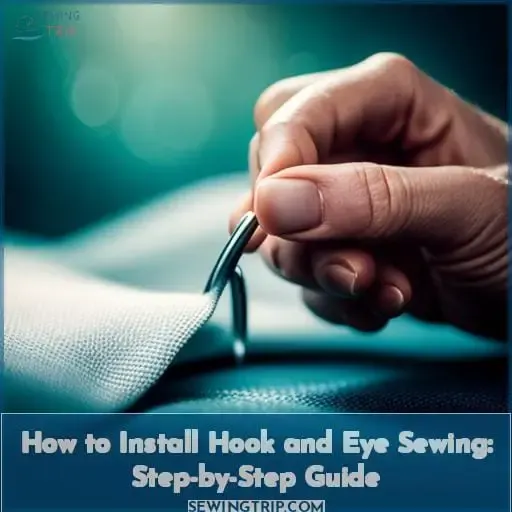 Hook and eye sewing is a simple and secure way to fasten garments. With the right tools and techniques, you can easily install hook and eye sewing on your own projects.
Hook and eye sewing is a simple and secure way to fasten garments. With the right tools and techniques, you can easily install hook and eye sewing on your own projects.
Table Of Contents
- Key Takeaways
- Supplies for Installing Hook and Eye Sewing
- Step-by-Step Instructions for Installing Hook and Eye Sewing
- Techniques for Creating Thread Loops for Hook and Eye Sewing
- Alternative Fastenings for Hook and Eye Sewing
- Tips and Tricks for Installing Hook and Eye Sewing
- How to Install Hook and Eye Sewing With a Sewing Machine
- Frequently Asked Questions (FAQs)
- Conclusion
Key Takeaways
- Choose the right hook and eye set based on strength and size.
- Mark the position of the hook and eye on the fabric’s underside.
- Stitch the hook and eye in place using a double thread.
- Test the closure to ensure that it is secure.
Supplies for Installing Hook and Eye Sewing
To install hook and eye sewing, you’ll need to choose the right hook and eye set based on strength and size.
You’ll also need essential tools such as a hand sewing needle, strong thread, scissors, and chalk or removable pen.
Choose the Right Hook and Eye Set Based on Strength and Size
To begin, choose the right hook and eye set based on the strength and size you need.
- Metal hooks and eyes are stronger than plastic ones, but plastic is less likely to rust.
- Small hooks and eyes are less visible than large ones.
Essential Tools: Hand Sewing Needle, Strong Thread, Scissors, Chalk or Removable Pen
What are the essential tools for installing hook and eye sewing?
- A hand sewing needle (sharps)
- Strong thread (double-thread)
- Scissors
- Chalk or removable pen
Step-by-Step Instructions for Installing Hook and Eye Sewing
To sew a hook and eye, first thread the needle with a double thread.
Then, mark the position of the hook and eye on the fabric’s underside.
Next, stitch the hook in place and sew the eye in place using the same method.
Thread the Needle
Prepare a double thread for a secure stitch.
- Wax the thread to prevent tangling.
- Knot the ends together.
- Thread the needle, leaving a tail of about 6 inches.
Mark the Hook and Eye Position
Mark the hook and eye position on the fabric’s underside with chalk or a removable pen.
Decide on opening finishing style (overlap or closure at edges).
Stitch the Hook
Stitching the hook involves securing the bill of the hook with a few stitches to prevent shifting.
Use tape to temporarily hold small hooks in place.
Stitch the hook firmly near the curved part on the wrong side, run the thread to the back, knot off, and remove the tape.
Sew the Eye
With the eye positioned next to the hook, sew it in place using the same method as the hook.
Avoid sharp points, use a thimble, sew close to the edge, and keep stitches even.
Test the closure to ensure it’s secure.
Techniques for Creating Thread Loops for Hook and Eye Sewing
To create secure closures for your hook and eye sewing, it’s important to master the techniques for creating thread loops.
-
Start with a knotted thread:
- Begin by threading a needle with a length of thread and tying a knot at the end.
- This will ensure that your loop remains secure throughout use.
-
Create four loops:
- Position the needle on the fabric where you want to create the loop, typically near where an eye would be placed.
- Make four equal-sized loops in one spot by wrapping the threaded needle around itself multiple times.
-
Use blanket stitch:
- To sew each loop in place, use blanket stitch technique along its circumference using small stitches close together.
- This will provide strength and stability to your thread loop.
By mastering these techniques, you can confidently create sturdy and reliable closures for all your hook-and-eye sewing projects.
Alternative Fastenings for Hook and Eye Sewing
When it comes to alternative fastenings for hook and eye sewing, you have a few options.
For overlapping closures, snaps, buttons, or Velcro can be used as convenient alternatives.
If your garment doesn’t have overlapping seams, zippers are a great choice that require seam allowances for insertion.
Snaps, Buttons, or Velcro for Overlapping Closures
For overlapping closures, consider using snaps, buttons, or Velcro as alternative fastenings to hook and eye sewing.
Choose the type, size, location, number, and color of snaps that best suit your project.
Zippers for Non-overlapping Closures
In the absence of overlap, use a zipper requiring seam allowances for insertion.
Consider zipper placement, length, type, and finish when choosing the right zipper for your project.
Tips and Tricks for Installing Hook and Eye Sewing
To ensure your hook and eye sewing is secure, you’ll need to:
- Secure your stitches and prevent them from shifting.
- Properly space and place your hooks and eyes.
Securing Stitches and Preventing Shifting
A few stitches will secure the hook and eye in place and prevent it from shifting.
Use tape to temporarily hold small hooks in place, and double stitch the hook near the curved part on the wrong side.
Knot the thread ends to avoid tangles, and make sure the eye placement is snug for a secure closure.
Proper Spacing and Placement for a Secure Closure
Since hook and eye closures are small and delicate, proper spacing and placement is critical for a secure closure.
For overlap closures, space the hooks 1 to 1.5 inches apart.
For non-overlapping closures, place the hooks at the edge of the fabric.
How to Install Hook and Eye Sewing With a Sewing Machine
To install hook and eye sewing with a sewing machine, you’ll need to follow these simple steps:
- Place the hook and eye on the fabric, with the hook facing up.
- Stitch around the hook and eye, using a short stitch length.
- Trim the excess thread.
- Press the seam allowances open.
This machine-friendly method is perfect for creating a secure and durable closure on overlapping or non-overlapping fabrics.
Frequently Asked Questions (FAQs)
What is the difference between a hook and eye and a snap?
A hook and eye is a fastener that consists of:
- A metal hook
- A metal eye
A snap is a fastener that consists of:
- Two metal pieces
- That snap together.
Can I use hook and eye sewing on stretchy fabric?
Hook and eye closures can be used on stretchy fabric, however, you’ll need to use a stretchy thread and sew with a stretch stitch to ensure the closure stays secure.
How do I attach a hook and eye to a zipper?
To attach a hook and eye to a zipper,
- First sew the hook to the right side of the fabric.
- Then sew the eye to the left side of the fabric, making sure that the hook and eye are aligned.
What is the best way to sew hook and eye sewing on leather?
To sew hook and eye sewing on leather, use a leather needle and waxed thread.
First, mark the placement of the hook and eye on the leather.
Then, use a drill to create a hole for the hook.
Finally, sew the hook and eye in place using a whip stitch.
How do I remove hook and eye sewing?
To remove hook and eye sewing, carefully pry the hook and eye apart with a thin, pointed object, such as a needle or pin.
Be careful not to damage the fabric.
Conclusion
Hook and eye sewing is a versatile and durable fastening method that can be used on a variety of projects. With a little practice, you can easily install hook and eye sewing on your own garments and accessories.

